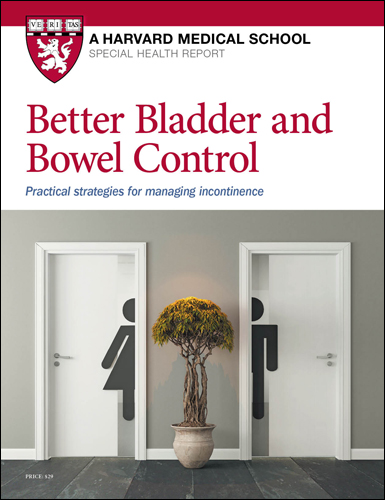Bracing for incontinence
As a woman gets older, she's more likely to experience certain forms of unintended urination.

Incontinence often sneaks up on women, becoming gradually more common with age. And recent numbers suggest that certain types of incontinence are sneaking up more than usual.
A study published in the August 2021 issue of the American Journal of Obstetrics and Gynecology found that between 2005 and 2018, among U.S. women ages 60 or older, the prevalence of urge incontinence (a sudden, unprovoked need to urinate) jumped from about 41% to 50%, stress incontinence (leaking urine with physical activity or pressure on the bladder) went from about 51% to 53%, and mixed urinary incontinence (a combination of urge incontinence and stress incontinence) went from about 24% to 31%.
It's not clear what caused the increases. The authors noted that all types of incontinence were higher among women with obesity, other health conditions, and a history of vaginal delivery.
Since most women report some kind of incontinence by age 70, it may help to learn about symptoms so you can identify them and seek help if needed. "These conditions can worsen over time, especially if they go untreated," notes Dr. Mallika Anand, a urogynecologist and director of the Center for Intimate Health and Wellness at Harvard-affiliated Beth Israel Deaconess Medical Center.
Urge incontinence
With urge incontinence, the overwhelming feeling that you need to empty your bladder can be followed by leakage before you make it to the bathroom. The upper part of the bladder, called the detrusor muscle, initiates urination when your bladder is full. In urge incontinence, this muscle squeezes involuntarily even if your bladder is not full. "A small portion of women have a type of urge incontinence called 'neurogenic bladder,' when nerves have been damaged in some way—for example, from a stroke or diabetes," Dr. Anand says. "But most women with urge incontinence have 'non-neurogenic overactive bladder,' when the bladder is very sensitive to fluid."
Treatments for urge incontinence include the following:
Lifestyle modifications. Avoid drinks that can irritate the bladder (caffeinated drinks, sodas, and alcohol) and schedule regular bathroom breaks. If you wake up at night to urinate, try to reduce fluids for an hour or two before bed. Managing constipation can also reduce urge incontinence.
Pelvic floor exercises. A trained pelvic floor physical therapist can help you learn to effectively squeeze and release the muscles near your bladder so you can retain urine until you can reach the bathroom.
Medications. Anticholinergic medications, such as oxybutynin (Ditropan), inhibit the tightening of the bladder muscle; sympathomimetics, such as mirabegron (Myrbetriq), increase bladder capacity. "Both types of drugs can have side effects, so you'll need to monitor them carefully," Dr. Anand advises.
Botulinum toxin (Botox) injections. Injections relax the detrusor muscle for three to 12 months. "There are potential side effects, such as bladder infection or temporary urine retention. You'll have to learn to catheterize yourself three times a day, until the Botox wears off slightly and your bladder empties more normally," Dr. Anand says.
Nerve stimulation. Your doctor can stimulate certain nerves with a needle or an implanted nerve stimulator to calm non-neurogenic overactive bladder.
Stress incontinence
If you leak urine when you cough, laugh, or exercise, it might be due to stress incontinence—leakage that occurs with pressure or physical force on the bladder. "This is a mechanical problem," Dr. Anand says. "The tissues that support the urethra [the tube that carries urine out of the body] have weakened, and when pressure on the bladder pushes urine toward the urethra, the weakness in the tissues allows urine to leak out. Another type of stress incontinence occurs when the lining of the urethra thins, allowing urine to drip out like an open pipe."
Treatments are designed to stabilize the urethra. They can include pelvic floor exercises, weight loss, and the following:
A vaginal pessary. This is a silicone device, professionally fitted and worn inside the vagina, that pushes against the urethra to keep it in place. There are also disposable over-the-counter pessary-like devices you can try.
Urethral bulking agents. Your doctor can inject fillers into the lining of the urethra to tighten the opening. It works immediately and may be helpful for people who can't tolerate surgery, but it's not permanent.
Bladder sling surgery. Your surgeon can attach a polypropylene sling to your connective tissues to support and stabilize the urethra. "This is done through a two-centimeter vaginal incision under the urethra. A trained surgeon should place the sling, and the sling will need time to stabilize," Dr. Anand says. "In about six weeks, you should be able to laugh with your friends again, without worrying that you'll have to run to the bathroom."
Image: © FatCamera/Getty Images
About the Author

Heidi Godman, Executive Editor, Harvard Health Letter
Disclaimer:
As a service to our readers, Harvard Health Publishing provides access to our library of archived content. Please note the date of last review or update on all articles.
No content on this site, regardless of date, should ever be used as a substitute for direct medical advice from your doctor or other qualified clinician.
















